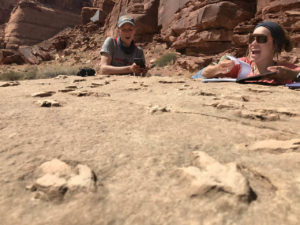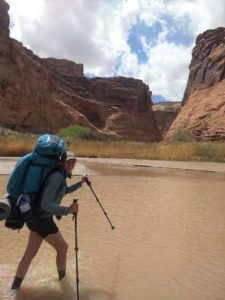 “Screedle on!” Someone shouts as we descend steep Navajo Sandstone slickrock. This is our third expedition as a group and we are each carrying twelve days worth of tightly packed gear on our backs. We appear to be defying gravity as we round a cliffside for our first glimpse of the Dirty Devil River far below. I am far too occupied with my foot placement and balance to fully appreciate the view, but the rest of our group is cheering me on and that makes all the difference. We reach the bottom of the canyon and breathe a sigh of relief as we look eagerly for beaver signs, consider the murky river, and snack on all the food within access in our enormous packs. We did it! We are back in the wild!
“Screedle on!” Someone shouts as we descend steep Navajo Sandstone slickrock. This is our third expedition as a group and we are each carrying twelve days worth of tightly packed gear on our backs. We appear to be defying gravity as we round a cliffside for our first glimpse of the Dirty Devil River far below. I am far too occupied with my foot placement and balance to fully appreciate the view, but the rest of our group is cheering me on and that makes all the difference. We reach the bottom of the canyon and breathe a sigh of relief as we look eagerly for beaver signs, consider the murky river, and snack on all the food within access in our enormous packs. We did it! We are back in the wild!
We are out here to learn about culture, geology, politics, and natural history. How better to learn about this place than to backpack through it–quite literally getting our feet wet. On our second day in the canyon, we got up close and personal with the Dirty Devil River to practice navigating its muddy waters in socks and sandals. Our feet squished as we were sucked into the river bottom up to our knees by quicksand, and we immediately competed to see who could bury their feet the farthest and fastest. Our group of WRFI students is extremely playful, and we make the most of our freedom to explore. Our laughter echoed off the Kayenta rocks around us, while our instructor, Katie, patiently taught us the easiest ways to escape the mud and probe with our hiking poles to seek our next steps. We trudged along finding our balance and marveling at giant bird tracks and muskrat footprints on the shallow mud. As we played baseball with pinon pine cones and threw mud balls to each other, we pestered Katie with questions about everything from the water quality to the rock layers and hypothesized about beaver habitats and gnat species. In this way, we experienced learning through play and exercised natural history and creativity to explore the world around us.
Colorful boulders
Slopes of Chinle Formation
Surely showing off
In addition to play, nature allows us to wonder boundlessly. We end up using our instructors, Katie and Dave, as search engines, but more often than not we are figuring out answers for ourselves through observation, experimentation, and research using our field guides. One of the major themes of the course involves systems thinking. With this perspective we’re learning to look at a variety of ecosystems as interconnected and our human impact and connection as well. As we descended through rock layers, we hiked a ways on an old mining road built through the Chinle formation. The road clearly demonstrates human effects on the ecosystems here; it was dozed decades ago to search for uranium that settles in the Chinle formation. The road exposed petrified wood and incredible colors in the rocks that stopped us in our tracks. Each rock formation led to countless discoveries and observations that engaged us throughout our journey.
Neat stacks of pebbles
Hub of ant activity
Abounding ant hills
Ants! They scurried from our path as we accidentally started to cook dinner right next to their hill. We have spent a lot of time wondering about ants as a group, and we often pause during hikes to watch large ant hills buzz with activity. We are aware of our impact on them just as much as their small, but itchy, impact on us and wonder about their carrying capacity, the lines they form, the neat uniform pebble collections that top their hills, and their role as a species in the greater scheme of the world. Asking deep questions about something so common as ant hills is a great exercise in humility, observation, and again, natural history. Our curiosity of the course extends to most everything else around us and how this place came to be. Nature allows us to have time and space to wonder freely, and I can tell you that there’s no shortage of curiosity in our group.
Geologic time
Petrified wood and dinos
We are but a blip
After learning about geologic strata that make up these canyon walls, we faced the challenge of imagining how long these rocks have been around. To wrap our minds around the vast time of Earth, we walked out 200 million years with each step representing one million years. As we went, we acted out some major events along the timeline including the formation of mountains, dinosaur reenactments, and the rise and fall of the ocean. When we looked back at our hike into the present, we saw that humanity’s era is only about one inch out of 400 feet or so. Looking even closer at that inch, it’s incredible to consider the amount of impact we’ve had on Earth’s temperature and cycle.
Between walls of rock
Singing songs of gratitude
Harmoniously
Our group has felt a deep connection to one another and this place around us as we’ve made our way down the Dirty Devil. We have immersed ourselves in a place that has both been drastically impacted by people and is destined for big change. As we spent nights sleeping below giant cliffs of Wingate, playing games after dinner, telling stories, and singing incessantly, we’ve built up our strength emotionally and physically. I feel a sense of belonging in this group we’ve formed of WRFI students and instructors and because we bonded to each other in this landscape, the Colorado Plateau feels all the more important in my life. Furthermore, since my connection to this place has solidified, I feel empowered and responsible for preserving it so others can have a similar experience as me. I have felt the “deep time” between these canyon walls and feel a connection with the ravens who have shown us their acrobatic prowess, the lizards sunning themselves for warmth, and even the plants who danced for us in an afternoon shower. There is something so natural about sleeping under the stars, building community in the outdoors, and experiencing joy through the natural intersection of systems. This place has been called home by many people before us, and despite our relatively short journey, our spirits have been captured by the Dirty Devil Canyon. 